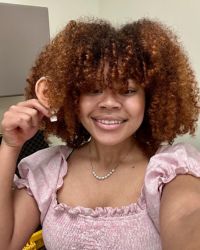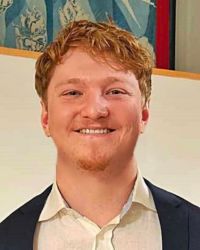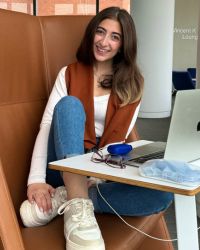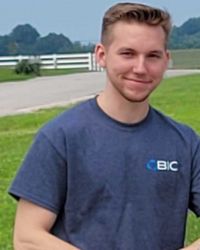On Friday, April 19, more than 500 undergraduate students at Case Western Reserve University will take to the Veale Convocation, Recreation and Athletic Center to present their research and creative projects at Intersections, a poster session administered by the Undergraduate Research Office.
Held each semester, the event is an opportunity for students to share the array of academic work they’re conducting with the academic community, which spans all disciplines—from arts and humanities to engineering, life sciences, physical sciences and social sciences.
To get a glimpse of what attendees can expect, The Daily sat down several students who will be presenting their work. Read on to learn more about their projects—and make a plan to attend Intersections between 11:30 a.m. and 2 p.m. tomorrow.
Answers have been lightly edited for clarity and length.

Aja Leatherwood
Third-year student majoring in communications science and psychology
- Tell us about the project you’ll be presenting!
My project investigates the potential of generative AI for creating materials and speech stimuli in audiological tests. There are two parts to my experiment: The first evaluates participants’ speech recognition accuracy by presenting sentences from both human female talkers and female-sounding AI-generated voices in noise and quiet; the second explores the participants’ ability to differentiate between human and synthetic voices, questioning if they can perceptually differentiate AI-generated speech.
The rationale behind conducting both parts concurrently is to determine whether there’s a significant difference in speech recognition between human and synthetic voices and if participants can reliably differentiate between the two. If the findings suggest that listeners cannot distinguish between synthetic and human voices and if speech recognition accuracy is not compromised by the use of generative AI in both noise and quiet environments, it would indicate that generative AI can be effectively employed to create diverse and realistic materials and speech stimuli for audiological testing.
- What did you enjoy most about working on this project? What kind of work went into it?
What I found most rewarding about this project was the comprehensive experience of conducting research from start to (near) finish. This included everything from fine-tuning the sentences and protocol and engaging with participants during the testing phase, to the thorough analysis of the data with my principal investigator, Lauren Calandruccio.
- Have you presented before?
I presented at Intersections 2023 with a project titled “Exposing Students to Careers in Communication Sciences: Innovative STEM Summer Camp Curriculum for Middle School Students” and came in second place for the Schubert@Intersections award.
- Why do you believe students should get involved with Intersections?
I believe Intersections offers an incredible opportunity for students to passionately present the projects they’ve devoted time to and receive valuable feedback. Additionally, it serves as an enriching experience that simulates a research conference; hence, providing students with a glimpse into the professional world of research.

Kaleb Chassie
Fourth-year neuroscience student with a concentration in the pre-med track
- Tell us about the project you’ll be presenting!
In my project, I present data on Mucopolysaccharidosis type VII (MPS VII), a lysosomal storage disorder. This disorder is caused by a loss-of-function of the extracellular matrix degrading enzyme, GusB. In my research, I provide evidence that microglial cells within the brain show preferential accumulation of extracellular matrix proteins and enlarged lysosomes. This discovery is important for leading the way for novel therapy for MPS VII that directly targets the genes of microglia.
- What did you enjoy most about working on this project? What kind of work went into it?
I really enjoyed working on this project by collaborating with labmates who share ideas and experiences. We all helped each other with specific aspects of our projects and I have enjoyed learning from all of the brilliant minds in my lab.
- Have you presented before?
Apart from small group presentations within our lab I have not presented before, so this will be my first public presentation of my research!
- Why do you believe students should get involved with Intersections?
I believe all students should participate in Intersections because it is an opportunity to share research on a topic that we are passionate about. It gives us an opportunity to show all of our hard work over the course of our capstone, or even just to get out of our shells and have a rare chance to improve our speaking skills.
Research is a tough process! Learning how to navigate the ups-and-downs of research and refining our techniques has a large learning curve. I am very grateful for having outstanding labmates and a [Primary Investigator] who helped me learn more in this past year than ever before. Research has the potential to bring people together to serve a common purpose and it has been an amazing experience.

Diala Izhiman
Fourth-year student majoring in communications science and psychology
- Tell us about the project you’ll be presenting!
I’m actually presenting two projects this year! The first one is part of my work in Cincinnati Children’s Hospital. It is the second wave of a longitudinal study looking into children with listening difficulties (LiD), but clinically normal audiograms. We employ speech-in-noise and complex tone perception testing in a cohort of children between the ages 8-15 years old to better understand the mechanisms involved in speech perception in LiD.
The second project is a product of my capstone seminar in social welfare. It looks into acoustic regulations and policymaking in educational and occupational settings, with a focus on classrooms and workplaces. This project was inspired by the often overlooked and dire need of acoustical accessibility in education and occupational settings. My capstone comprises a literature review surveying the acoustic standards in classrooms across the [United States] and Europe and investigating the effects of poor acoustics on speech intelligibility, and academic performance as well as looking into the current acoustical standards present in classrooms across the U.S.
- What did you enjoy most about working on this project? What kind of work went into it?
I think the most enjoyable and rewarding aspect of working on these projects was the academic and intellectual freedom to explore areas within my field that piqued my curiosity. It allowed me to find ways to incorporate components of my background and experiences within concepts of audiology and speech perception. Inevitably, that has allowed me to reach a level of academic and intellectual maturity that I could not have achieved otherwise. For instance, interacting with patients in data collection at Cincinnati Children’s Hospital, analyzing data and producing a paper truly solidified my exploration and understanding of the fine interactions between the clinical and theoretical components of auditory research.
The literary review and analysis that comes with working on a research project was just as valuable. Not only did it prompt me to read and learn more, but it also helped me pinpoint and reflect on the gaps in literature and consequently address them in my own work.
- Have you presented before?
Yes! I have had the honor of presenting at the American Auditory Society (AAS) this past February, alongside my mentor, David Moore. It was a great opportunity to reconnect with work colleagues as well as establish new connections with fellow students and professionals. AAS allowed me to engage in thought-provoking discussions around the gaps in our practice and consider the measures needed to increase inclusivity in cultural competency in clinical research and service delivery.
- Why do you believe students should get involved with Intersections?
I believe that involvement in such opportunities goes beyond just the presentation day. Preparing for presentations—whether through analyzing data, identifying trends, or drawing meaningful conclusions—fosters a space for critical thinking and a deeper interaction with academic curiosities.
I think one of the most valuable insights a student can take from such opportunities comes from the questions, discussions, and feedback that takes place during and after the presentations. In my past poster presentation experiences, these discussions have challenged me to approach my own research from different lenses and have inspired me to form questions that delve into more sophisticated and complex depths of our auditory perception.
Overall, opportunities like Intersections encourage students to delve deeper into their research topics, fostering intellectual curiosity and academic growth. It also provides recognition for students’ academic achievements, which is a catalyst for further professional growth.

Matthew Hoffman
Fourth-year student majoring in materials science and engineering, with minors in physics and data science
- Tell us about the project you’ll be presenting!
I will be presenting my work on developing a device that can perform automated cold sintering processes on dielectric ceramics, which my mentor Alp Sehirlioglu and I have termed a “sinterometer.” The device is designed to control the temperature and uniaxial pressure being applied to a ceramic powder in order to produce a densified, low-porosity, functional ceramic material, and it does so via PID algorithmic control of a series of heat cartridges and of a hydraulic press system.
My objective over the course of the program was to finalize my design of the sinterometer, so that I could begin assembling and programming the device over the course of the academic year.
- What did you enjoy most about working on this project? What kind of work went into it?
This project was undeniably very challenging, but it gave me the opportunity to grow as a researcher and an engineer in a multitude of ways. The learning process and getting to execute on the design I had developed was definitely the most enjoyable part of this project. Beyond the work that went into learning about material processing, hydraulic fluid systems, resistive heating components, and programming control methods for the aforementioned systems in python, I also learned the value of having the confidence to make decisive choices when necessary in the design process.
- Have you presented before?
I have not presented this particular project before, and this will also be my first time presenting at Intersections, and I am very excited to do so!
- Why do you believe students should get involved with Intersections?
I believe students should get involved in Intersections because the program gives the opportunity to conduct research or embark on a project of interest with their mentor during a time when that project can actually be a priority over the summer. This gives students a better chance for success and lets them dive deeper into their venture of interest in a manner that they otherwise would not have gotten the chance to.
This article was originally published April 17, 2024.

